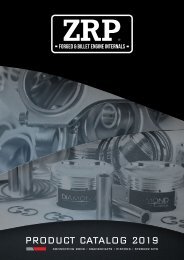ZRP_Catalog_2017
Create successful ePaper yourself
Turn your PDF publications into a flip-book with our unique Google optimized e-Paper software.
Connecting Rods<br />
Billet Crankshaft<br />
technical | Installation instructions | Connecting Rods<br />
Installation Instructions<br />
Please read installation thoroughly before starting work. When they are completely understood proceed<br />
with installation<br />
1. CriticaL Steps<br />
a. The first thing you need to do when you get the bolts is to measure them so you are sure you have the correct size<br />
b. Always apply ARP moly lube on the threads and under the head of the bolts when torqueing.<br />
c. Please note that many bolts may look alike but have differences. After you have measured the bolts, then you must<br />
clean the threads of the rods and bolts very well. Install rods by positioning cap and beam into alignment.<br />
d. Each rod is numbered and MUST be assembled with the same number on the cap and beam.<br />
e. Sequentially torque bolts to specified torque NOT to exceed<br />
2. Rod Torque / Stretch Specs<br />
1 2 3 4 5 6 7 8<br />
Material Thread Uhl Thread Grip Length Head Height Wrench Collar Diam. Rec/ded Torque<br />
Size (in.) (in.) Length (in.) (in.) (in.) Size (in.) (in.) (ft/lb)<br />
ARP2000 5/16 1.500 0.550 0.150 0.348 3/8 0.526 25<br />
ARP2000 3/8 1.500 0.550 0.100 0.388 7/16 0.555 45<br />
ARP2000 3/8 1.600 0.600 0.100 0.388 7/16 0.555 45<br />
Installation instructions<br />
Please read installation thoroughly before starting work. When they are completely understood proceed<br />
with installation.<br />
1. Clean and prepare the engine block<br />
Please clean carefully the engine block and all components to ensure perfect bearing placement. By far the best way to<br />
remove all gallery plugs and all the dis-assembled engine to soak in a agitated chemical bath. This way all the sludge and<br />
dirt accumulations are removed. If chemical cleaning facilities are unavailable, you can use the less desirable method with<br />
a solvent such as Kerosene. It is imperative to ensure that the entire lubrication system is completely clean and free of<br />
obstructions.<br />
2. Check NIP and back contact<br />
It is necessary to check the NIP or crush fit of the new bearings in their housing and also the back contact if the old bearing<br />
backs have any bright, shiny areas. The procedure of this operation is:<br />
A. Apply a coating of the bearing “blue” to the cleaned tunnel seating and the joint faces of the case or cup<br />
B. Clean and try the bearings and apply the bearing “blue” to the joint faces on one bearing. Assembly the bearings in<br />
to the housings, tightening the holding bolt evenly to the correct tension. Threads should be oiled.<br />
C. Accurately measure and right down the assembled internal diameters of each pair of bearings, then release the<br />
bolt or bolts on one side only. This should allow the joint faces to separate on this side. A feeler guide of 0.10mm to<br />
0.15mm should be accepted into the opening.<br />
technical | Installation instructions | Billet Crankshaft<br />
ARP 8740 7/16 1.600 0.600 0.200 0.388 7/16 0.644 60<br />
ARP L19 3/8 1.500 0.550 0.100 0.388 7/16 0.555 60<br />
D. Release the remaining bolts and dismantle the bearing unit completely. An examination of the housings and the<br />
bearings should reveal an even transference of “blue”<br />
i. Tunnel bores to back of bearings<br />
ii. One bearing joint face to the other<br />
iii. The cap joint face to the case joint face or vice-versa<br />
An uneven transference of blue indicates some “off standard” condition to be investigated and corrected.<br />
We recommend to only using the supplied ARP Ultra<br />
torque fastener assembly lube. This lube reduces<br />
friction about 25-30% in comparison to engine oil.<br />
The above mentioned values are valid only if the<br />
thread and seat area of the bolt has been lubed<br />
properly!!!<br />
1. Check oil clearance<br />
With tunnel sizes correct to specification and shaft journal unworn or correctly ground undersize, ACL finished-to-size<br />
bearings will provide a correct operating clearance which can be quickly confirmed on assembly with the use of flexi<br />
gauge. Where doubt exists, or in special case, oil clearance should be checked by accurately measuring and writing down<br />
each journal diameter and then subtracting this from the corresponding internal bearing diameters that where noted when<br />
checking the amount of nip. The difference between the two diameters represents the vertical oil clearance and this<br />
must fall within the specified tolerance shown against each part number in the alphabetical list.<br />
24 25





